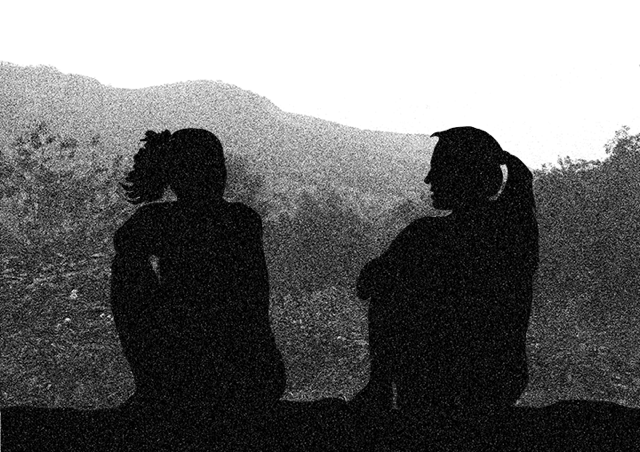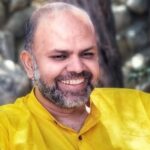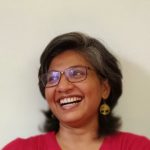“The best and safest thing is to keep a balance in your life, acknowledge the great powers around us and in us.
If you can do that, and live that way, you are really a wise man.”
-Euripides
The Experience of Internal Alignment

Are there moments when you have a feeling of being completely centered? Of being coherent and clear? Take a moment to reflect: can you remember a time when a piece of action flowed out of you spontaneously, without thought, and fell into harmonious place outside?
We may associate such moments more frequently with earlier phases of our life, such as childhood. Look at how infants play and learn – with an utter lack of self-consciousness and yet full of self-awareness.
Traditional Indian wisdom recognises this experience of centering and alignment as a phenomenon that can be accessed and acted from. Shilpa Shastram calls it the experiencing of the ‘Kaya Madhya Sutram’ (KMS), finding the subtle thread (sutram), which runs right through the centre (madhya) of the body (kaya) and holds one together, in an integrated manner.
This state of internal integration gets dislocated in the course of life experiences and daily living, and we find ourselves and others feeling and acting out of balance and alignment.
It is however possible to cultivate and experience this alignment in a conscious manner. People from all walks of life, irrespective of whether they work with their bodies intensely (for instance, dancers, sports persons) or not, can find this inner balance constantly.
Kaya Madhya Sutram – An Offering

“In the beginning, mountains are mountains,
And waters are waters.
Then the mountains are not mountains
And waters are not waters.
Later, mountains are once more mountains,
And waters, waters.”
-Zen saying
Each one of us can experience and cultivate this inner balance. Yoga says that each starts from where he/she is, and have their unique experiences and unfolding. Coming together in a supportive group setting with people from diverse backgrounds makes the learning richer with an experience of group dynamics and realities. It is also important to remember that this process of finding the inner alignment is constant and ongoing – it is possible to find deeper and subtler meanings of the mountains and waters mentioned in the Zen saying above, as we walk on the path.
Ritambhara offers the programme, Kaya Madhya Sutram, as an opportunity to get in touch with this central axis, through various activities and theoretical sessions, based on Yoga and Shilpa Shastram primarily.
In December 2017, a group of participants experienced the KMS at a small retreat in Hyderabad. Priya Nagesh and Kamala, discuss their experiences and insights of the program.

K: The KMS process at Hyderabad this time (Dec 2017) was really intense, wasn’t it?
P: Yes, I think the exchanges and reflections went quiet deep. We had practitioners and teachers of Asana-Pranayama, and Yoga therapists as well who attended. Perhaps the habit of svadhyayam (self-reflection / study) was quite deeply established amongst us, and supported us in this exploration.
K: That is true. KMS as a Retreat for those of us not working with our bodies on a daily basis would be very different, from a process for more ‘advanced’ practitioners. Beginners can experience the retreat in an intensely, personal way. They see big chunks of reflections of themselves, maybe for the first time! However, say, people doing therapy work, may start understanding the cognitive or theoretical framework.
P: That’s exactly what happened for me. The first time I participated in KMS, my Asana-Pranayama practice shifted to a deeper level. The Asana practice has become like Pranayama because of the attention to the breath and the central aligning. In KMS this time around, I had a consistent Antaranga Sadhana in place, and could shine the torchlight inside in a focused way. I could step back and see the larger picture, not just allowing the experiences to take place, but many times choosing them. I think what was happening was an assimilation of the reflective components into the cognitive framework. The awareness or observation of what was actually happening was the added bonus this time.
K: Exactly! I resonate with what you are saying. It is so clear from the process that the Kaya Madhya Sutram programme is like a threshold from Bahiranga Sadhana to Antaranga Sadhana (External to Inner practice). Earlier, though I had incorporated breath, I had still been a heavy Asana practitioner, inclined towards perfecting my Asanas. After the first KMS, one of my experiences was particularly Sukham (Ease / Expansion / comfort) in movement, along with the Sthiram (Stability). I began to understand movement and Asana and why a certain Asana is needed at a certain point, just not something that I Have to do. It became very meditative. Then in subsequent KMS events, I was able to see how different people engage in movement with themselves and each other, and that is helping me to help others.
P: So, even those of us who are completely new, say to an asana-pranayama practice, but hold a questioning, curious mind, will find this meaningful?
K: Yes, absolutely! The body becomes a space for inquisitiveness and something to look into. And there starts the inner work! So you see, we are giving the framework and space for integrating body and breath and inner experiences, at the level of Annamaya (Physical / gross) and Pranamaya (energy / subtle), experiencing emotions and feelings, and also witnessing and working with them in a cognitive way.
P: The first day, we use statis and movement, symmetry and asymmetry, and sound, to locate our inner alignment. We follow it up with an exploration of our emotional world on the second day…
K: And the third day’s experience puts it all together in our narratives and relationship with the world. We engage in this process, like in a conversation. A contemplative conversation programme..
P: Yes, a taste of the aligning within.
The Kaya Madhya Sutram is a unique program, offered by Ritambhara at several venues in India. If you would like to participate in the next Kaya Madhya Sutram, write to us at [email protected]


 Anoop is a student of Yoga, an entrepreneur, a coach and a father of two young boys. He has led successful leadership stints in both the corporate and non-for-profit sectors. On encountering the country’s water/farmer crises at close quarters, he decided to pause and examine the impact various ‘isms’ – capitalism, colonialism, etc., were having on us as individuals, families, the society and the environment at large. This quest led him to formally engage with traditional Indic knowledge systems while also learning from the latest advances in science – about our physical and mental wellbeing, importance of body and mind work in healing trauma and the urgent need for a conscious rebuilding of family / work / social structures if we have to thrive individually and collectively. Insights, frameworks and processes gleaned from these on-going studies, an anchorage in his own personal practice and his wide-ranging experiences is what Anoop brings to facilitation/coaching spaces in Ritambhara and his various professional engagements.
Anoop is a student of Yoga, an entrepreneur, a coach and a father of two young boys. He has led successful leadership stints in both the corporate and non-for-profit sectors. On encountering the country’s water/farmer crises at close quarters, he decided to pause and examine the impact various ‘isms’ – capitalism, colonialism, etc., were having on us as individuals, families, the society and the environment at large. This quest led him to formally engage with traditional Indic knowledge systems while also learning from the latest advances in science – about our physical and mental wellbeing, importance of body and mind work in healing trauma and the urgent need for a conscious rebuilding of family / work / social structures if we have to thrive individually and collectively. Insights, frameworks and processes gleaned from these on-going studies, an anchorage in his own personal practice and his wide-ranging experiences is what Anoop brings to facilitation/coaching spaces in Ritambhara and his various professional engagements.
 Priya is a Yoga therapist in the Krishnamacharya tradition. She adapts Reiki & energy work, Vedic chanting, life coaching & Ayurvedic practices in her healing spaces. She is committed to nurturing collectives that have the praxis of Yoga at their heart.
Priya is a Yoga therapist in the Krishnamacharya tradition. She adapts Reiki & energy work, Vedic chanting, life coaching & Ayurvedic practices in her healing spaces. She is committed to nurturing collectives that have the praxis of Yoga at their heart. Anisha has been on an exploration to understand herself through yoga for the last 15years which led her to teaching yoga, yoga therapy and inner work through yoga.
Anisha has been on an exploration to understand herself through yoga for the last 15years which led her to teaching yoga, yoga therapy and inner work through yoga. Apoorva chanced upon Yoga in her early 20s. A spark was lit within and there was no turning back. Her exploration led her to the Krishnamacharya tradition more than a decade ago. Curious about human behaviour and what drives it, she was thrilled when her search ended (and also began) when she first came upon the Yoga Sutra, which illuminated a path towards answering many questions that had been held for a long time.
Apoorva chanced upon Yoga in her early 20s. A spark was lit within and there was no turning back. Her exploration led her to the Krishnamacharya tradition more than a decade ago. Curious about human behaviour and what drives it, she was thrilled when her search ended (and also began) when she first came upon the Yoga Sutra, which illuminated a path towards answering many questions that had been held for a long time. Anita is a yoga teacher and therapist in the tradition of Sri.T.Krishnamacarya and Sri T.K.V. Desikachar, a Reiki practitioner and a Life Coach. She is also the founder of Vishoka, a center for learning Indic and energy-based frameworks for living and healing. Her deep concern for human suffering and the problems of unsustainable living kept her on the path of seeking an integrated approach to looking at life, living, learning and healing.
Anita is a yoga teacher and therapist in the tradition of Sri.T.Krishnamacarya and Sri T.K.V. Desikachar, a Reiki practitioner and a Life Coach. She is also the founder of Vishoka, a center for learning Indic and energy-based frameworks for living and healing. Her deep concern for human suffering and the problems of unsustainable living kept her on the path of seeking an integrated approach to looking at life, living, learning and healing. Ankit is a seeker in the wisdom traditions of India. The core of his work includes creating dialogic spaces where people can look within and see the connection between their inner and outer lives. Inspired by the likes of Gandhi, Aurobindo, Vivekananda and Guru Gobind his experiments in service took him back to his roots in Punjab where he is creating a community-led model of higher education which is open, inclusive and accessible for all. Ritambhara for him is a space for engaging in a community which is committed to a DHramic life. He anchors his work of learning and leadership in the Antaranga Yoga Sadhana and the humanistic wisdom of Mahabharata.
Ankit is a seeker in the wisdom traditions of India. The core of his work includes creating dialogic spaces where people can look within and see the connection between their inner and outer lives. Inspired by the likes of Gandhi, Aurobindo, Vivekananda and Guru Gobind his experiments in service took him back to his roots in Punjab where he is creating a community-led model of higher education which is open, inclusive and accessible for all. Ritambhara for him is a space for engaging in a community which is committed to a DHramic life. He anchors his work of learning and leadership in the Antaranga Yoga Sadhana and the humanistic wisdom of Mahabharata.